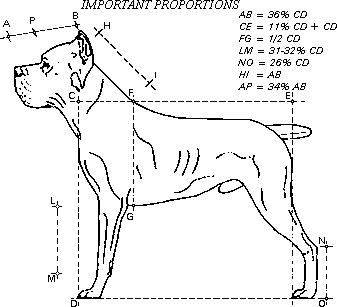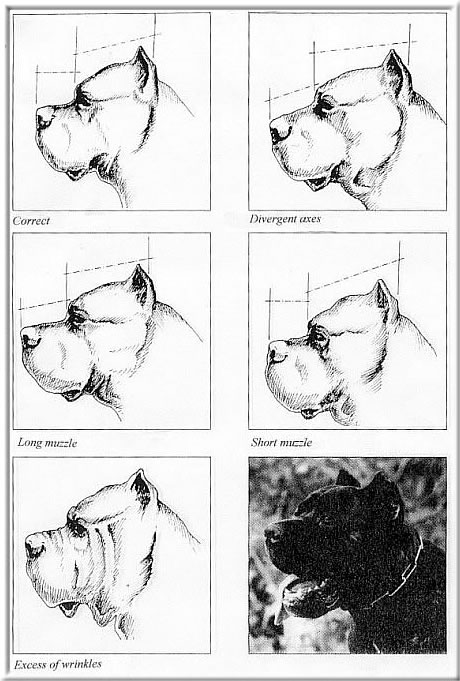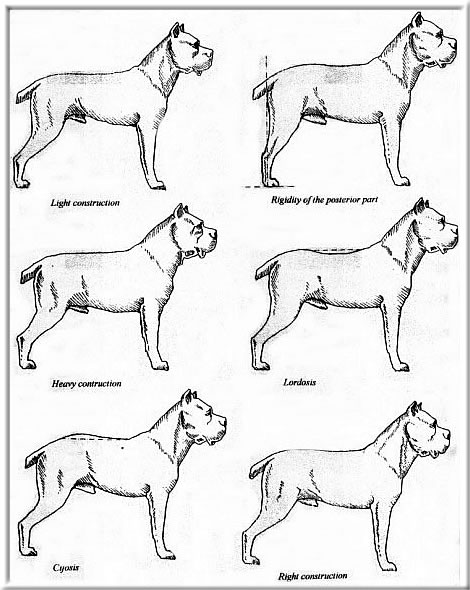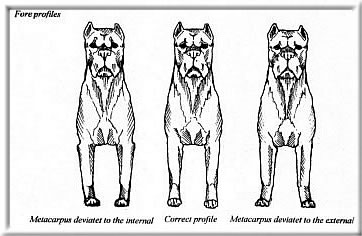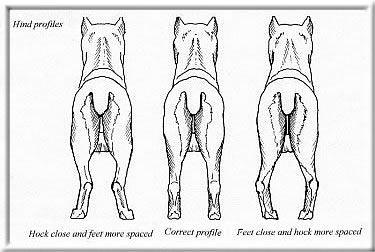|
|
The Cane Corso is a very loyal breed. They have
a very stable temperament. They are protective yet very gentle.
They do well with children in the family. They are very energetic
and trainable. They require daily exercise, they can make great
jogging buddies. The life expectancy for the Cane Corso is 10
to 11 years. I found this information on the " Rare Breed Network" website, I thought it was interesting and wanted to share it. Italian authorities believe that the Cane Corso is one of two breeds which stem directly from the Roman Molosser It is said that, in ancient times, the historic Molossus gave rise to two quite different breeds. One dog was very massive and became the progenitor of the Neapolitan Mastiff. The other was a taller, lighter and less cumbersome dog, known for his quickness and agility. From this very athletic Molossus sprang today's Cane Corso. In medieval times, the Cane Corso was used as a big game hunter. His power, courage and agility made him especially valuable on wild boar. It is also reported that he was used on stag and bear. Italian fanciers of the breed say, proudly, the Corso is "the only true coursing mastiff." With the decline in big game hunting, the Corso found a home with Italian farmers. He was often used as a drover, moving animals to market or to the slaughterhouse. On the farm, he protected livestock from both human thieves and animal predators. He also doubled admirably as a guard dog for the home. Indeed, to this day he can still be seen throughout rural Italy performing these old duties. What is the Cane Corso like to live with? "They're great dogs," Mike Sottile says. "Although they are superb protection dogs, they are quiet around the house. They're not at all noisy. They love their family and need lots of personal hands-on attention. There's a lot of eye contact with this breed. I'm very impressed with their intelligence. They always seem to be thinking. It's like you can just see the wheels turning. They are so eager to please that they are usually at your side just waiting for your next command." Despite the breed's size, they make excellent house dogs. The Cane Corso definitely needs socialization, and it is strongly urge that owners obedience train their dogs. Properly raised and trained, the breed is suspicious of strangers, but wonderful with the family. When raised correctly, the dog should be submissive to all members of the family. "This breed gets along very well with children. They are protective, yet gentle. The Cane Corso has a very stable temperament," Mike observes. Ettore Frassinetti says that the breed "Devotedly loves his owners, his family and in particular children with whom he behaves delicately and gently ."
FCI
(Italian) BREED STANDARD
Translation:
Dr. Antonio Morsiani , Dr. J.M. Paschoud and Prof. R. Triquet Cranial Region Skull:
Wide; at the zygomatic arches its width is equal to or greater
than its length. convex in front, it becomes fairly flat behind
the forehead as far as the occiput. The medio-frontal furrow is
visible Facial Region Nose:
Black and large with ample, open nostrils, on the same line as
the nasal bridge. Eyes:
Medium-sized, ovoid, looking directly forward, slightly protruding.
Eyelids close fitting. Color of iris as dark as possible depending
from the color of the coat. expression keen and attentive.
Body: The body
is somewhat longer than the height at the withers. sturdily built,
but not squat. Tail: Set on fairly high; very thick at the root. The tail is docked at the fourth vertebra. In action carried high, but never curled nor erect.
LIMBS: Forequarters:
Hindquarters:
Gait/Movement: Long stride, extended trot. The preferred gait is the trot. Skin: Fairly thick, rather close fitting Coat: Size
and Weight:
Faults: Any departure from the foregoing points should be considered a fault and the seriousness with which the fault should be regarded should be in exact proportion to its degree. Severe
Faults: Eliminating
Faults:
ICCF (American) BREED STANDARD Medium-large sized molossoid, sturdy, compact, with a strong skeleton, muscular and athletic, it moves with considerable ease. Its head is massive, with a dignified and proud expression. It has had a selection parallel to that of the mastiff, it comes from lighter progenitors but has maintained that original conformation. It has always been a property watchdog and hunter of difficult game, such as the boar. It originated in the central-southern regions of Italy where it was used as a cowherd for cows and swine raised in the wild. It also defended travellers and carters from highwaymen. Its name is the one by which it has always been known in the south, having the same root as "corsiero" (courser), the medieval war horse; perhaps it derives from the Latin "cohors" (courtyard, body guard). Due to environmental changes, the Courser risked extinction. A few enthusiasts initiated its recovery which today is complete. Its modern functions are watchdog, defending people and their belongings. An adaptable and courageous worker, of proverbial loyalty, alert and reactive, who is able to withstand difficult environmental conditions and experiences due to its solid equilibrium,. A strong build but not without elegance. Built on a rectangle, it absolutely must not resemble the Neapolitan Mastiff. Its skin adheres to its body and does not form wrinkles. UTILIZATION - Watch, protection, police, and track dog. CLASSIFICATION - Working group 1, dogs like Argentine Dogo and Black Russian Terrier. BRIEF HISTORICAL SUMMARY - Its direct ancestor is the "Canis Pugnax" (the old Roman Molossian) of which he is the light version employed in the hunting of large wild animals and also as an "auxiliary warrior" in battles. For years he has been a precious companion of the Italic populations. Employed as property, cattle and personal guard dog and used for hunting purposes too. In the past this breed was common all over Italy as an ample iconography and historiography testify. In the recent past he has found an excellent preservation area in Southern Italy, especially in Puglia, Lucania and Sannio. His name derives from the Latin "Cohors" which means "Guardian", "Protector". GENERAL APPEARANCE - Medium-big size dog, strongly built but elegant, with powerful and long muscles, very distinguished, he expresses strength, agility and endurance. The general conformation is that of a mesomorphic animal whose body is longer than the height at the withers, harmonious as regards the form and disharmonious as regards the profile. IMPORTANT PROPORTIONS - The length of the body is about ll% over the height at the withers. The total length of the head reaches 3,6/10 of the height at the withers. The length of the muzzle is equal to 3,4/10 of the total length of the head. The height of the thorax is 5/10 of the height at the withers and it is equal to the height of the limb at the elbows. BEHAVIOUR AND TEMPERAMENT - Intelligent, active and even-minded, he is an unequalled watch and protection dog. Docile and affectionate with the owner, loving with children and with the family, if necessary he becomes a terrible and brave protector of people, house and property. He is easily trained. HEAD - Brachycephalic. Its total length reaches 3,6/10 of the height at the withers. The bizygomatic width, which is equal to the length of the skull, is more than half the total height of the head, reaching 6,6/10. The upper longitudinal axes of the skull and of the muzzle are slightly convergent. The perimeter of the head, measured at the cheek-bones, is more than twice the total length of the head even in the females. The head is moderately sculptured with zygomatic arches stretched outwards. The skin is firm and sticking to the tissues underneath, it is smooth and quite stretched. CRANIAL REGION - Skull - Seen from the front it is wide and slightly curved, seen from the side it draws an irregular curve that, accentuated in the subregion of the forehead, becomes flat along the external saggital crest. Seen from the top, it looks square because of the outstretching of the zygomatic arches and the powerful muscles swathing it. Frontal sinuses well developed and stretched forward, deep forehead hollow and visible median furrow. Occipital crest not much developed. Supraorbital fossae slightly marked. Stop - Very marked because of the very developed and bulging frontal sinuses and because of the prominent superciliary arches. FACIAL REGION - Nose - It is on the same line as the nose pipe. Seen from the side it mustn't stick out from the front vertical margin of the lips but be, with its front, on the same vertical line as the front of the muzzle. It has to be voluminous, rather flat on top, with wide nostrils, opened and mobile, wet and cool. The pigmentation is black or dark grey. Muzzle - Very broad and deep. The width of the muzzle must be almost equal to its length, which reaches 3,4/10 of the total length of the head. Its depth is more than 50% the length of the muzzle. Due to the parallels of the muzzle sides and to the fullness and the width of the whole jaw, the anterior face of the muzzle is flat and square. The nasal bridge has a rectilinear profile and it is rather flat. The lower side profile of the muzzle is determined by the upper lips, the suborbital region shows a very slight chisel. Lips - Rather firm. Seen from the front, the upper lips form at their disjunction an upside down "U" and, seen from the side, hang moderately. The commeasure is rightly evident and it always represents the lowest point of the lower side profile of the muzzle. The pigmentation is black. Jaws - Very wide, strong and thick, they can have a very slight shortening of the upper jaw with a subsequent light prognathism (undershot bite). The branches of the lower jaw are very strong and, seen from the side, are quite curved, the body of the lower jaw, well accentuated forward, points out well the marked chin. The incisors are firmly placed on a straight line. Cheeks - The masseter region is full and evident, but not hypertrophic. Teeth - White, big, complete in growth and number. The bite should be slightly undershot (max 5mm) or level. A scissor bite would be tolerated only if all parameters (length of the muzzle, parallel muzzle sides, the upper longitudinal axes of the skull and of the muzzle are slightly convergent) The canines would be divergent and very distant among them (in the males, in the apex of the crown, they would need to be not less than 5,5 cm/5,7 cm apart). Eyes - Of medium size compared to the size of the dog, in a sub-frontal position, well spaced. Rima palpebrarum nearly oval, adherent eyelids with the borders pigmented with black, the eye mustn't let the sclera be seen. Third eyelid strongly pigmented. The color for the subjects with a black muzzle (black, tawny and brindle) iris as dark as possible. For the subjects with gray muzzle (gray, tawny and brindle)light brown color, lighter colorations are approved. Ears - Of medium size in relation to the volume of the head and to the size of the dog; covered with short hair, of triangular shape, with rather pointed apex and thick cartilage, in a high position, much above the zygomatic arch, with a wide bottom, hanging, they stick to the cheeks without coming down to the throat. Quite outstretched and slightly protruding at the joint, they become semi-erect when the dog is watchful. They usually get amputated in an equilateral-triangular shape. NECK - Top line - Slightly arched. Length - 3,6/10 of the height at the withers, that is equal to the total length of the head. Shape - Of oval section, strong, very muscular, with a marked disjunction form at the nape. The perimeter, at half length of the neck, is about 8/10 of the height at the withers. Harmoniously joined with the withers, shoulder and chest, the neck has its ideal direction at 45ƒ from the ground and at right angle with the shoulder. Skin –The inferior part of the neck introduces more abundant but elastic skin. BODY - Compact, strong and very muscular. Its length is 11% over the height at the withers, with allowance of ±1%. Top line - The back region is rectilinear with a slightly lumbar convexity. Withers - They clearly rise on the dorsal line and over the rump level, are high, long, wide. They are lean and joint harmoniously to the neck and to the back. Back - It is wide, very muscular as the whole upper line of the trunk, slightly climbing from the back to the front and with a strictly rectilinear profile. Its length is approx. 32% of the height at the withers. Loins - The lumbar region has to be short, wide, well joined to the back and to the rump, very muscular, very solid and, seen from the side, slightly convex. Its length, slightly higher than its width, is equal to 20% of the height at the withers. Croup - It is long, wide, quite round due to the considerable growth of the muscles. The length, measured from the ridge of the hip to the ridge of the nates is equal to 32% of the height at the withers. Its average width is equal to 23% of the height at the withers, its inclination on the horizontal line, on the basis of the ilium-ischiatic line is of 28ƒ/30ƒ, on the basis of the line from the ridge of the hip to the insertion of the tail is of 15ƒ/16ƒ. Therefore the rump is slightly inclined. Chest - Wide, well inclined and open, with well grown muscles. Its width, in close relation with the width of the thorax, reaches 35% of the height to the withers; the breast-bone is at the same height as the tip of the shoulders. Seen from the side, the chest is outstretched forward between the fore legs and slightly convex. Thorax - It has to be well grown in the three dimensions with long, oblique, wide and well hoped ribs with wide intercostal spaces. The 4 false ribs are long, oblique and open. The thorax reaches down at the elbow and its height is equal to half the height at the withers. Its width, measured at half of its height, is equal to 35% of the height at the withers and decreases slightly towards the sternum region without forming a carina. The depth (saggital diameter) is equal to 55% the height at the withers. Its perimeter is over 35% the height at the withers. Underline and belly - The sternum region is lean, long, wide and seen from the side it outlines a semicircle with a wide radius which caudally goes up smoothly to the abdomen. The abdomen region is neither hollowed nor relaxed and, seen from the side, rises up from the sternum edge to the groins with a smooth curve. The hollow on the side is not very marked. Tail - It is inserted quite high on the rump line, it's thick at the root and not too tapering at the tip, and if stretched is not too much over the hock. When not in action is low. Otherwise is horizontal or slightly higher than the back, it must never be bent to form a ring or in a vertical position. It gets amputated at the 4th rib. LIMBS o FOREQUARTERS - Perpendicular, seen from the front or in profile. The height of the limbs at the elbows is equal to 50% of the height at the withers. Well proportioned to the size of the dog. Strong and powerful. Shoulder - Long, oblique, strong, equipped with long, powerful and well divided muscles, is adherent to the thorax but free in the movements. Its length, from the top of the withers to the ridge of the shoulder, is equal to 30% of the height at the withers and its inclination on the horizontal line is between 48ƒ/50ƒ. In relation to the median plane of the body the ridges of the shoulder-blades are slightly swerved. Arm - It is slightly longer than the shoulder, strong, with very well grown bones and muscles, well joined to the trunk in its top 2/3, measured from the ridge of the shoulder to the tip of the elbow, it has a length equal to 31/32% of the height at the withers and an inclination with the horizontal line of approx 58ƒ/60ƒ. Its longitudinal direction is parallel to the median plane of the body. The angle between the shoulder-blades and the humerus is between 106ƒ and 110ƒ. Elbows - The elbows, long and protruding, adherent but not too close to the ribcage, covered with lean skin, must be like the humeri, on a strictly parallel plane to the sagittal plane of the trunk. The tip of the elbow (olecranon epiphysis) is located on the vertical line lowered from the caudal (or back) angle of the shoulder-blade to the ground. Forearm - It is perfectly vertical, oval section, with several muscles, in particular in the top-third, with a very strong and compact bone structure. Its length, from the tip of the elbow to the one of the arm is equal to 32/33% of the height at the withers. Its perimeter, measured straight underneath the elbow, is equal to 39% of the height at the withers, the carpus-cubital groove is quite marked. Carpal joint - Seen from the front, it follows the straight vertical line of the forearm; it is lean, wide, mobile, thick. Its perimeter reaches 26% of height at the withers, at its top margin the pisiform bone is strongly projected backwards. Pastern - It is quite smaller than the forearm, is very strong, lean, elastic, slightly flexed (it forms with the ground an angle of approx. 72/73ƒ). Its length must not be over one sixth of the height of the forelimb at the elbow. Seen from the front, it follows the perpendicular line of the forearm and of the carpus. Forfeet - They have a round shape, with very arcuated and gathered toes (cat's foot). Lean and hard soles. The nails are strong, curved and pigmented, there is a good pigmentation also in the plantar and digital pads. o HINDQUARTERS - Perpendicular, seen from the front or in profile. Well proportioned to the size of the dog, strong and powerful. Thigh - It is long and wide, with prominent muscles, therefore the nate ridge is well marked. Its length is over 33% of the height at the withers and the width is never lower than 25% of such height. The thigh-bone axis, quite oblique from the top to the bottom and from the back to the front, has an inclination of 70ƒ on the horizontal line and forms with the coxal axis an angle which is slightly more than right (coxo-femural angle). Second thigh - It is long, lean, with a strong bone and muscle structure, has a well marked muscular groove. Its length is equal to 32% of the height at the withers and its inclination from the top to the bottom and from the front to the back is of approx. 50ƒ on the horizontal line. Stifle - The angle of the stifle joint is of approx. 110ƒ. Its direction is parallel to the median plane of the body. Hock joint - It is wide, thick, and clean, with well marked bone. The protruding hock ridge shows clearly the continuation of the leg groove. The distance from the ridge of the hock to the sole of the foot (to the ground) shouldn't be over 26% of the height at the withers. Its direction, in relation to the median plane of the body is parallel. The tibio-metatarsal angle is of approx 130ƒ. Hock (Metatarsus) - It is very thick, lean, rather short, cylindrical, and is always perpendicular to the ground, seen from the side and from the back, its length is equal to approx 15% of the height at the withers (tarsus and foot excluded). Its internal side has to present itself without spur. Hindfeet - They have a slightly more oval shape than the fore ones and less arched toes. GAIT/MOVEMENT - Long steps, stretched trot, some steps of gallop, but with inclination to stretched trot. SKIN - It is, rather thick, has limited subcutaneous connective tissue and therefore is adherent everywhere to the layers underneath. The neck is practically without dewlap. The head mustn't have wrinkles. The pigment of the mucous membranes is black. The pigment of the soles and the nails must be dark. COAT - Hair - Short hair but not smooth, with vitreous texture, shiny, adherent, stiff, and very dense, with a light layer that becomes thicker in winter (but never crops up on the covering hair). Its average length is approx. 2/2,5 cm. On the withers, the rump, the back margin of the thighs and on the tail it reaches approx. 3 cm without creating fringes. On the muzzle the hair is very short, smooth, adherent and is not more than 1/1,5 cm. Colour - Black, plumb-grey, slate, light grey, light fawn, deer fawn, dark fawn and tubby (very well marked stripes on different shades of fawn and grey). In the fawn and tubby subjects there is a black or grey mask only on the muzzle and shouldn't go beyond the eye line. A small white patch on the chest, on the feet tips and on the nose bridge is accepted. HEIGHT AND WEIGHT - Height at the withers - For males from 25.6-26.8 inches (tolerance +/- 0.75”) for females from 24.4-25.6 inches. (tolerance of ± 0.4”.) Weight - Males from 103 (97) to 117 (123) pounds. Females from 88 (84) to 101 (106) pounds. The lbs in the parenthesis reported weights to the tolerances in height. FAULTS - Any departure from the foregoing points should be considered a fault and the seriousness with which the fault should be regarded should be in exact proportion to its degree and diffusion. o ELIMINATING FAULTS - Head - Accentuated parallelism of the axes of the skull and the muzzle very marked converging axes of the skull and the muzzle, converging side lines of the muzzle, scissors bite, pronounced and disturbing undershot mouth. Nose - Partial depigmentation. Tail - Forming a ring or in a vertical position. Size - Oversize or undersize. Gait/movement - Continued amble. o DISQUALIFYING FAULTS - Head - Diverging axes of the skull and the muzzle, overshot mouth nose bridge resolutely hollow or ram-like. Nose - Total depigmentation. Eyes - Partial and bilateral palpebral depigmentation, wall-eye, bilateral strabismus. Sexual organs - Monorchidism, cryptorchidism, obvious incomplete growth of one or both testicles. Tail - Tailless, short-tail, artificial or congenital. Hair - Semi-long, smooth, fringed. Colours - All colours not prescribed, white patches too wide. Note - Males should have two apparently normal testicles fully descended into the scrotum. International Cane Corso Federation, 2003 |
|
Content and Design Copyright 2005-2016 © Avalanche Cane Corso & About Time Design All rights reserved. |
